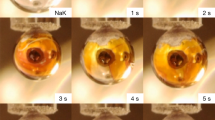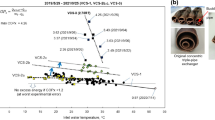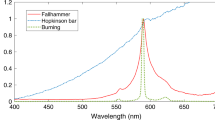Abstract
IT has been suggested recently1 that observed, yields1,2 (g(−H2O) ∼ 7 ± 1) from the radiolysis of water vapour in the presence of chemical scavengers could be explained by considering the energetics of charge neutralization of the hydrated species H3O+(H2O)n (reaction 1) instead of the simple hydronium ion H3O+ (reaction 2):  Support for this hypothesis is provided by the mass spectrometric investigations of Kebarle and Hogg3 and of Knewstubb and Tickner4, who have identified hydrates of the form H3O+(H2O)n, with n = 1 − 7, using α-radiation and electric discharges in water vapour. This communication presents preliminary evidence, principally from the radiolysis of water vapour containing 5 mole per cent cyclohexane, with some supporting evidence from work with the system water/ammonia, which demonstrates the chemical consequences of reactions (1) and (2), and enables us to estimate the enthalpy change in the general hydration reaction:
Support for this hypothesis is provided by the mass spectrometric investigations of Kebarle and Hogg3 and of Knewstubb and Tickner4, who have identified hydrates of the form H3O+(H2O)n, with n = 1 − 7, using α-radiation and electric discharges in water vapour. This communication presents preliminary evidence, principally from the radiolysis of water vapour containing 5 mole per cent cyclohexane, with some supporting evidence from work with the system water/ammonia, which demonstrates the chemical consequences of reactions (1) and (2), and enables us to estimate the enthalpy change in the general hydration reaction: 
This is a preview of subscription content, access via your institution
Access options
Subscribe to this journal
Receive 51 print issues and online access
$199.00 per year
only $3.90 per issue
Buy this article
- Purchase on Springer Link
- Instant access to full article PDF
Prices may be subject to local taxes which are calculated during checkout
Similar content being viewed by others
References
Anderson, A. R., Knight, B., and Winter, J. A., Trans. Faraday Soc. (in the press).
Baxendale, J. H., and Gilbert, G. P., Faraday Soc. Disc., 36, 186 (1963).
Kebarle, P., and Hogg, A. M., J. Chem. Phys., 42, 798 (1965).
Knewstubb, P. F., and Tickner, A. W., J. Chem. Phys., 38, 464 (1963).
Freeman, G. R., and Ramaradhya, J. M., J. Chem. Phys., 34, 1726 (1961).
Burns, W. G. (personal communication).
Fiquet-Fayard, F., J. Chimie Physique, 57, 453 (1960).
Appleyard, R. K., Nature, 164, 838 (1949).
Wingate, C., Gross, W., and Failla, G., Rad. Res., 8, 411 (1958).
Nat. Bureaux Sci. Circular No. 500.
Tal'rose, V. L., and Frankevitch, E. L., J. Amer. Chem. Soc., 80, 2344 (1958).
Bell, R. P., The Proton in Chemistry (Methuen and Co., Ltd., London, 1959).
Author information
Authors and Affiliations
Rights and permissions
About this article
Cite this article
ANDERSON, A., KNIGHT, B. & WINTER, J. Effect of Temperature on the γ-Radiolysis of Water Vapour. Nature 209, 199–200 (1966). https://doi.org/10.1038/209199a0
Issue Date:
DOI: https://doi.org/10.1038/209199a0
This article is cited by
Comments
By submitting a comment you agree to abide by our Terms and Community Guidelines. If you find something abusive or that does not comply with our terms or guidelines please flag it as inappropriate.



